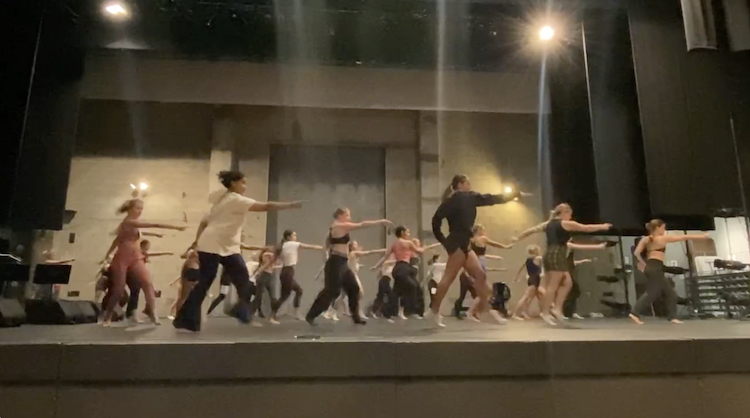
Dancers pride themselves on making their craft appear effortless.
This may be why many students don’t realize Pepperdine’s student-led dance company, Dance in Flight, puts eight months of effort into the company’s annual show.
Pepperdine’s Dance in Flight is a renowned tradition on campus, especially around the spring show. The organization tends to fly under the radar in the first semester when, instead of being on stage, dancers are in rehearsals from 8:00 a.m. to 9:00 p.m. every Saturday.
“The people I talk to now are shocked that auditions were so soon into the year and we do practice every weekend,” said Carly Duerre, a sophomore psychology major and first-year Dance in Flight member. “So I feel like not that many people know it’s so often and not just second semester.”
Several members of the Dance in Flight organization discussed the perception of DIF on campus and the significance of it being student-led. They emphasized the relationships and enjoyment they gain from the Dance in Flight program that make the time sacrifices worth it.
Dance in Flight flies under the radar
Dance in Flight rehearsals begin in August and run until the show in March. Many members of the Pepperdine community don’t seem to be aware of these rehearsals and instead seem to associate Dance in Flight with only their final product.
“I don’t hear about it a lot on campus, I feel like I definitely hear about it more often when the time is like coming near,” said Rosabella Chavez, a sophomore psychology and political science double major who attended Dance in Flight’s show last spring. “Like right now I haven’t heard anything about it, I feel like as time gets closer, people start to talk about it more, and as it’s more advertised it starts to get more recognition.”
As someone who is not affiliated with Dance in Flight, Chavez said really only hears information about it from her friends who are members of the company.
“I do feel like it definitely doesn’t get as much recognition as it should,” Chavez said. “Especially for the, like, time commitment that it is and how much work people put into it.”
The community has supported Dance in Flight, but it has not reached a very broad audience, said Amelia Gish, a senior psychology major and Dance in Flight’s marketing coordinator.
“A lot of people don’t really know Dance in Flight exists,” Gish said.
Katie Price, the campus programs coordinator who produces Dance in Flight, said Dance in Flight does not get very much attention in the fall semester from Pepperdine’s on-campus media sources, such as PeppPost and The Graphic. Instead, most of their coverage is from the company’s own Instagram page,
“Especially in the fall there’s not very much publicity around it,” Price said. “Even though our dancers are still rehearsing for over 12 hours a day every Saturday.”
Similarly, Price said the community doesn’t recognize Dance in Flight’s hard work until the spring.
“I feel like people only see the show part of it and only see the final result,” Price said.
The reality of being a student-led organization at Pepperdine
One of Dance in Flight’s most distinguishing features is that it is student-led.
Being a student-led organization provides students with the opportunity to learn how to make hands-on decisions and freely express their creativity, said Simone Chaddha, a senior advertising major and Dance in Flight’s assistant director.
“Dance in Flight gives us the opportunity to have our voices heard,” Chaddha said.
This is a shift from many other dance environments. Typically, in a competitive dance environment, there is an authoritative figure who makes most of the decisions for the dancers, Chaddha said.
“As a dancer, you’re more so just like a moving piece in the puzzle as opposed to sort of like a game maker as well,” Chaddha said.
The intense nature of traditional dance environments — as opposed to Dance in Flight’s more open and collaborative approach — can also lead to challenges such as burnout and stress injuries.
Dancers face similar physical obstacles to other athletes, but due to the lack of a distinct season, they rarely have the opportunity to rest to prevent injury or burn-out, Manuela Angioi wrote in a 2009 article in Medical Problems of Performing Artists.
The Pepperdine staff members associated with Dance in Flight do not contribute to the choreography or other creative processes, Price said. All of those responsibilities and the credit goes to the student directors.
“There’s me and a staff member who do logistics,” Price said. “But we really do leave it up to the students.”
A student-led organization has both its pros and cons. Being a student-led organization can make it harder to promote the company, Gish said. On the contrary, because DIF doesn’t work with outside organizations, their budget is based on the money they made the year prior, allowing the dancers to directly benefit from their hard work.
Being a student leader in DIF garners a lot of responsibility.
“Our responsibilities include choreographing the opening number and the closing number, running the auditions, and ultimately facilitating a smooth and co-collaborative environment between all of the dancers,” Chaddha said. “All while working with our director and producer.”
One of the creative liberties the student leaders possess is the selection of the annual show’s unique theme. The theme for the 2023 show was Symbiosis. This show used visuals and choreography to represent connections and interactions between the dancers, reflecting dynamics such as conflict/resolution and mentor/student.
Pepperdine has a strict moral code, which is something student leaders must consider when selecting songs, costumes and themes. In 2016, the theme for the show was Social Movements of the 1960s. In this show, Pepperdine censored Dance in Flight for including routines that did not align with Pepperdine’s beliefs.
Price said Pepperdine’s ideals have not really influenced the shows other than needing to use clean songs.
“Our directors had a vision and we’re able to do the exact vision they want,” Price said.
DIF is a substantial time commitment for the dancers.
Members of Dance in Flight give up their Saturdays to rehearse for the spring show.
“A lot of people don’t realize that DIF is a production from the very beginning,” Gish said. “So when we start with auditions we are starting our show. Even pre-auditions we are planning our show, we’re planning our themes, we’re planning our costumes, we’re planning everything.”
Gish said Dance in Flight occupies more of her time than just the Saturday rehearsals.
“This year I am a choreographer for Dance in Flight so it adds a little bit more to my schedule,” Gish said.
Taylor Faas, a senior business administration major and Dance in Flight’s student director, said the rehearsal schedule makes it harder to catch up on homework or accommodate weekend travel.
“Time-wise it is definitely a huge sacrifice,” Faas said. “You know, to give up your Saturday to rehearse.”
The Saturday rehearsals run from around 9 a.m. to around 9 p.m., and depending on the number of dances members are in, they spend varying amounts of time in these practices.
“The greatest challenge is waking up every Saturday morning at 9 a.m.,” Duerre said. “The schedule is like all day Saturday, so you don’t really get a weekend.”

Why it is all worth it
Despite the hectic schedule, Dance in Flight members continue to show up at rehearsals and make the time sacrifice.
Mya Kough, Dance in Flight’s staff director, wrote in an email that Dance in Flight creates a community and gives people the opportunity to dance with others who share the same passion.
The annual Dance in Flight show is the final product that gives the dancers something to show for all of their hard work.
“If a dancer is looking to prove how hard they worked, then I feel like that’s definitely super easy to see through them dancing in the show,” Chaddha said.
The show week is a very busy but also very enjoyable time for the dancers.
“My favorite part would have to be show week,” Faas said. “It’s just so much fun.”
Gish said Dance in Flight presented her with a special community.
“Dance in Flight is honestly the reason I’ve stayed at Pepperdine,” Gish said.
Duerre and Chaddha both said they experience this close-knit community and consider it worth the difficult hours.
“It’s nice to see more familiar faces on campus,” Duerre said.
The time sacrifices may appear to be grueling, but the dancers view them as worth it in exchange for a close community and a chance to spend time doing something they are passionate about.
“It is also the most rewarding thing, too,” Faas said. “Even though it is a sacrifice to give up a day off your weekend, it is extremely fun and you get to, you know, just dance with a bunch of people that you love.”
Gabrielle Kolb completed the reporting for this story in Jour 241 under the supervision of Dr. Christina Littlefield and Dr. Theresa de los Santos. Dr. Littlefield supervised the web version of the story.



